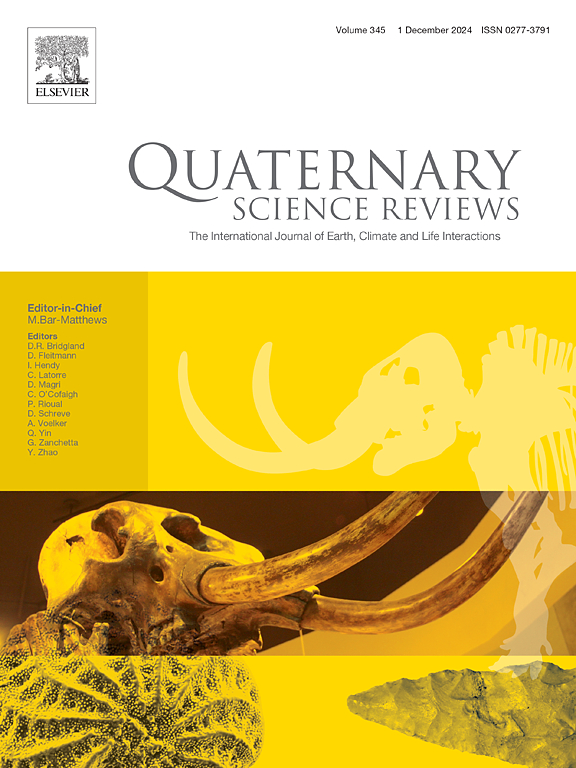Sensitivity to climate and vegetation dynamics of a peatland record from central Cameroon during the African Humid Period
IF 3.2
1区 地球科学
Q1 GEOGRAPHY, PHYSICAL
引用次数: 0
Abstract
Significant climatic and vegetation changes have occurred in tropical Africa over the Holocene, especially during the African Humid Period (AHP). However, the complexity of interpreting and comparing several proxies from diverse sites complicates the characterization and differentiation of climatic and environmental changes at local, regional and global scales. This study investigates a 6-m peat core from the Ngaoundaba maar volcanic crater (Northeastern Cameroon, later simply called Ngaoundaba), spanning the last 10 ka using pollen analysis and a large panel of lipid biomarkers. We produce new high-resolution, continuous, multiproxy records of vegetation, temperature, and precipitation spanning most of the Holocene. All of these proxies indicate a substantial transition approximately 5.7–5.6 ka cal BP, which is supported by cluster analyses and marks the end of the AHP. A shift from an open-water to a vegetated peatland, the disappearance of some wooded species, and the expansion of grass and sedge pollen all indicate significant local and regional changes. The gradual terrestrialization of peat surfaces also had an impact on lipid biomarker proxies. An unusual extensive variation in hydrogen isotopic composition (D/H) of long-chain n-alkanes during the Holocene, in contrast to other records from West and Central Africa, may be attributed to the increased contribution from local wetland plants, including sedges and grasses, which thrive in peat water that is more D-enriched than rainwater, peat water being the water accumulating in the wetland. Likewise, temperature variations reconstructed using bacterial branched glycerol dialkyl glycerol tetraethers (brGDGTs) are influenced by confounding factors, like changes in peat pH or moisture levels, which may be constrained using our multiproxy methodology. The temperature record from Ngaoundaba indicates a slight increase in temperature during the mid-Holocene relative to pre-industrial levels. The Ngaoundaba peat deposit documents a massive and abrupt shift in vegetation at the end of the AHP, linked with changes in precipitation amount and/or seasonality, which also significantly affected the peat microbial community. The Ngaoundaba peat record, because of its high sensitivity to climatic and environmental changes, is a crucial new source for understanding the end of the African Humid Period in Western Central Africa.
非洲湿润期喀麦隆中部泥炭地记录对气候和植被动态的敏感性
全新世以来,特别是非洲湿润期(AHP),热带非洲发生了显著的气候和植被变化。然而,解释和比较来自不同地点的几种代用物的复杂性使得在地方、区域和全球尺度上气候和环境变化的特征和分化变得复杂。本研究对Ngaoundaba maar火山口(喀麦隆东北部,后来简称为Ngaoundaba)的6米泥炭岩芯进行了调查,使用花粉分析和大量脂质生物标志物,跨越了过去10 ka。我们制作了新的高分辨率、连续、多代理的植被、温度和降水记录,涵盖了全新世的大部分时间。所有这些代理都表明了5.7-5.6 ka cal BP的实质性转变,聚类分析支持这一观点,并标志着AHP的结束。从开放水域到植被泥炭地的转变,一些树木物种的消失,以及草和莎草花粉的扩大都表明了重大的局部和区域变化。泥炭表面的逐渐陆地化也对脂质生物标志物指标产生了影响。与西非和中非的其他记录相比,全新世长链正烷烃氢同位素组成(D/H)的异常广泛变化可能归因于当地湿地植物的贡献增加,包括莎草和禾草,它们在泥炭水中生长,泥炭水比雨水更富D,泥炭水是湿地中积累的水。同样,使用细菌支链甘油二烷基甘油四醚(brGDGTs)重建的温度变化也受到混杂因素的影响,如泥炭pH值或湿度水平的变化,这些因素可能会受到我们的多代理方法的限制。恩oundaba的温度记录表明,在全新世中期,温度相对于工业化前水平略有上升。Ngaoundaba泥炭沉积在AHP结束时记录了植被的大规模突变,与降水量和/或季节性变化有关,这也显著影响了泥炭微生物群落。由于对气候和环境变化的高度敏感性,Ngaoundaba泥炭记录是了解中非西部非洲湿润期结束的重要新来源。
本文章由计算机程序翻译,如有差异,请以英文原文为准。
求助全文
约1分钟内获得全文
求助全文
来源期刊

Quaternary Science Reviews
地学-地球科学综合
CiteScore
7.50
自引率
15.00%
发文量
388
审稿时长
3 months
期刊介绍:
Quaternary Science Reviews caters for all aspects of Quaternary science, and includes, for example, geology, geomorphology, geography, archaeology, soil science, palaeobotany, palaeontology, palaeoclimatology and the full range of applicable dating methods. The dividing line between what constitutes the review paper and one which contains new original data is not easy to establish, so QSR also publishes papers with new data especially if these perform a review function. All the Quaternary sciences are changing rapidly and subject to re-evaluation as the pace of discovery quickens; thus the diverse but comprehensive role of Quaternary Science Reviews keeps readers abreast of the wider issues relating to new developments in the field.
 求助内容:
求助内容: 应助结果提醒方式:
应助结果提醒方式:


